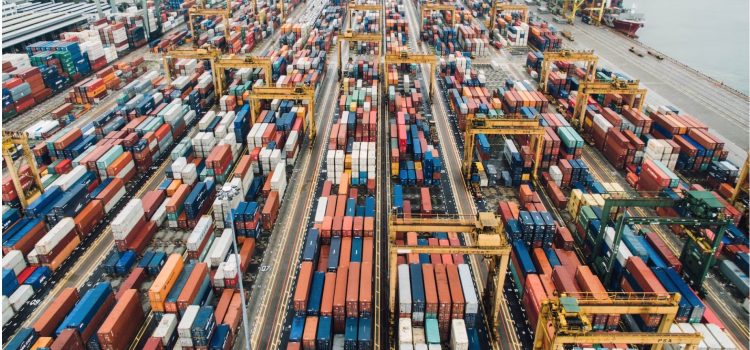
This is a free excerpt from one of Shortform’s Articles. We give you all the important information you need to know about current events and more.
Don't miss out on the whole story. Sign up for a free trial here .
What are the biggest global supply chain issues right now? What factors will continue to affect the supply chain in the long term?
The current global supply chain disruptions were sparked by the pandemic response and compounded by surging demand, transportation snarls, and the war in Ukraine. Experts were pessimistic mid-year but are now predicting a return to normality in early 2023.
Read on to learn why we may still face long-term global supply chain issues, despite predicted improvements.
Global Supply Chain Issues
It’s been a bumpy couple of years for global supply chains. When the pandemic threw the global economy into a tailspin in 2020, store shelves emptied as global supply chain issues exposed weaknesses in the just-in-time delivery model retailers had long relied on. When the economy roared back to life in 2021, transportation snarls stranded goods on ships and at ports, leading to more empty shelves. Then, just as that problem eased, the war in Ukraine blocked shipping channels and sent the price of energy skyrocketing throughout Europe, creating logistical challenges and adding to operating costs.
The good news is that most of these problems seem to be easing. After some pessimistic mid-year predictions, experts are now predicting a return to normality early next year. But even if they’re correct in the medium term, there are longer-term complications on the horizon.
An Unrelenting Series of Supply Chain Shocks
The current global supply chain issues were triggered by the international pandemic response in early 2020. Factory closures, spikes in demand for medical equipment and protective gear, shelter-in-place orders, and panic buying wreaked havoc with normal patterns of supply and demand.
Due in part to the deliberate efforts of governments around the world, the post-pandemic economy bounced back quickly. This surging demand put pressure on still-reeling supply chains, leading to more shortages, higher prices, and ongoing headaches for those trying to predict future supply-and-demand patterns.
Transportation challenges complicated things further. Extreme shipping congestion in late 2021 and early 2022 saw massive queues at ports and a record percentage of goods stuck on idling ships, while truck driver shortages and strikes made it difficult to move goods over land.
Finally, the outbreak of war in Ukraine compounded existing problems and caused new ones. Blockages of key ports and overland rail shipping routes obstructed exports of wheat and sunflower oil, threatening global food supply chains. Suddenly pivoting away from Russia also proved challenging in the transportation sector, with Russians accounting for over 10% of the world’s shipping workers.
Staying Warm Will Be More Difficult and Costly
As fuel prices skyrocket due to issues with the global supply chain, experts warn that many around the globe could face a long cold winter this year. Oil and natural gas markets are always affected by global factors, and this year the Russian invasion of Ukraine is exacerbating already-existing fuel supply shortages.
While supply and distribution chains are still trying to recover from pandemic-related slow-downs, which had already increased heating costs substantially since the winter of 2020-21, the Russia-Ukraine war will cause those costs to soar even higher this year.
Since Russia is Europe’s biggest natural gas supplier, Europe will likely feel the tightest squeeze in the near future, as Russia limits exports to those countries supporting Ukraine. In expectation of this, European countries scrambled over the summer to fill their gas reserves by importing from Norway, North America, and Africa. Because of this, they’re currently well-stocked, but with the global demand exceeding supply, this stock won’t last long. Whether it’ll even last through this winter will depend on how cold it is, and how frugal citizens are.
The American fuel supply is precarious as well. Sanctions on Russia prohibit oil and natural gas imports. And since the U.S. was one of the countries that exported natural gas to Europe over the summer, domestic supplies of that are lower than usual.
All of this means rising costs for heating this winter for many European and American citizens. Some countries will be worse off than others, though. France produces much of its own electricity through nuclear power, so it’s less dependent on Russian gas, and the French government is also subsidizing fuel costs for its citizens.
Other European countries such as Germany, Italy, and the U.K. are facing a greater crisis. Across Europe, people are now hurriedly converting their home heating systems to wood, and scrambling to buy wood fuel for the winter. This is leading to a sharp increase in the price of wood, as well as environmental concerns about air pollution and tree removal from forests.
A Return to Normality…
Given these issues, it’s not surprising that just a few months ago experts were pessimistic about the future of the global supply chain. However, supply chain indicators have steadily improved over the last five months, and many experts are now predicting a return to normality in March 2023.
This improvement is partly because port backlogs are easing and transportation costs have declined. However, the main driver of the readjustment is more concerning: declining consumer demand due to increasing living costs. Global trade volumes are shrinking, with manufacturing and retail the hardest-hit sectors. While low demand will ease pressures in the short term, in the longer term it could put suppliers out of business—starting the supply-side woes all over again.
… But for How Long?
While things are returning to normal in the medium term, there’s more turbulence on the horizon.
Transportation complications continue to bite, with a dock worker strike in the U.K. and potentially another in the U.S., where workers in Mobile, Alabama, were poised to strike this month (although they hadn’t done so as of this writing). Inflation and high energy costs will have knock-on effects—16% of German companies, for example, are predicting slowdowns due to increased operating costs. Europe’s ballooning energy prices will also cause issues with global food supply chains: Fertilizer production in Norway, Lithuania, Hungary, and Poland has dropped by over 70% due to the cost of natural gas. These issues will cause more damage to a food supply chain already trying to work around heavy sanctions on Russia (previously the world’s top fertilizer exporter).
Other geopolitical issues and uncertainties may also affect global supply chains moving forward. U.S.-China tensions, for example, have already led to the temporary closure of a key shipping route through the Taiwan Strait. Taiwan produces 65% of the world’s semiconductors and over 90% of all advanced chips, meaning that any disruptions on the island would ricochet through nearly all global supply chains.

Want to fast-track your learning? With Shortform, you’ll gain insights you won't find anywhere else .
Here's what you’ll get when you sign up for Shortform :
- Complicated ideas explained in simple and concise ways
- Smart analysis that connects what you’re reading to other key concepts
- Writing with zero fluff because we know how important your time is






